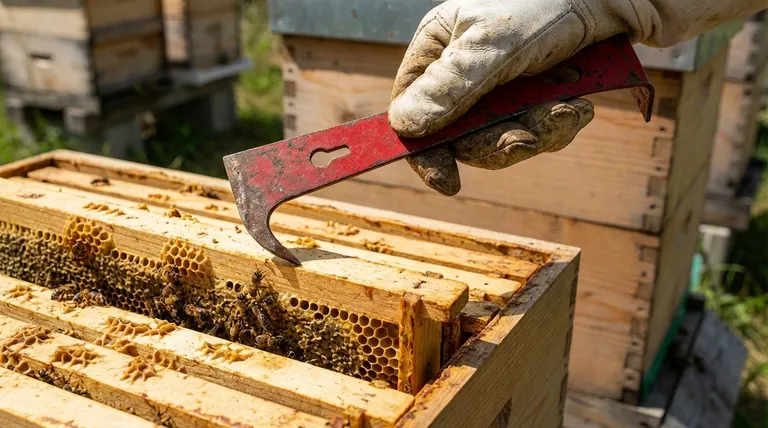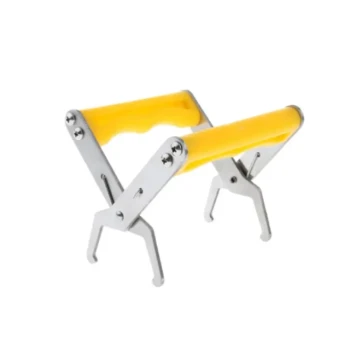The defining feature of a Red 'J' Type hive tool is its distinctive J-shaped hook, specifically designed for levering frames out of the hive with precision. Unlike a standard hive tool, which functions more like a mini crowbar, the J-type uses its curved end to hook under a frame's lug and rests its shoulder on an adjacent frame, providing controlled leverage. Its narrow profile and low cost are also key characteristics.
The core purpose of a 'J' Type hive tool is not brute force, but finesse. It excels at the delicate and crucial task of lifting frames with minimal disturbance to the bees, a specialization that sets it apart from more versatile, all-purpose hive tools.

Deconstructing the 'J' Type Hive Tool
While all hive tools are used for prying and scraping, the 'J' type is engineered around one specific, high-frequency task: frame inspection. Its design choices all serve this primary function.
The Signature 'J' Hook
The tool gets its name from its most important feature. The curved hook is designed to fit perfectly under the lug of a hive frame.
By placing the small shoulder of the tool on the top of an adjacent frame, you create a simple and effective lever. This allows you to lift a propolis-sealed frame straight up without jarring the comb or rolling bees.
A Narrow, Ergonomic Profile
The tool is intentionally narrow. This slim design allows a beekeeper to crook the tool in their little finger while holding a frame with the same hand.
This simple ergonomic feature means the tool is always at the ready, eliminating the need to put it down and pick it up between inspecting each frame.
The Beveled Scraper End
The end opposite the hook is typically a simple, flat blade with a sharpened bevel.
This end serves the general-purpose functions of a hive tool: scraping away excess wax and propolis from hive components or prying apart less stubborn parts of the hive.
How It Compares to the Standard Hive Tool
Understanding the 'J' type requires comparing it to the more common "crowbar" style hive tool, which many beekeepers also own.
The "Mini Crowbar" Alternative
A standard hive tool is a flat piece of steel, often with one bent or curved end. It's thicker, wider, and heavier than a J-type.
Its design provides a large surface area for scraping and immense leverage for prying, making it ideal for separating hive bodies that are heavily sealed with propolis.
The Core Functional Difference
The standard tool is built for power. It's the right choice for the heavy work of breaking the seal between supers or deeps.
The J-type tool is built for precision. It is the superior choice for the delicate work of lifting individual frames out of a tightly packed box.
Understanding the Trade-offs
Choosing a hive tool is not about finding the "best" one, but the right one for the job at hand. The J-type's specialized design comes with clear benefits and limitations.
Strength in Specialization
The J-type's ability to lift frames with targeted, gentle leverage is its greatest strength. This reduces stress on the colony and minimizes the risk of damaging comb or harming the queen.
The Limitation: Heavy-Duty Prying
The narrow design that makes the J-type so nimble also makes it less effective for separating hive bodies. It lacks the width and heft to distribute prying force effectively, and using it for this task can damage your woodenware.
Cost vs. Versatility
The Red 'J' Type is often the least expensive hive tool available. This makes it an excellent starting point for new beekeepers. However, because of its specialization, many experienced beekeepers own both a J-type and a standard tool, using each for its intended purpose.
Making the Right Choice for Your Workflow
Your choice of tool should align directly with the task you are performing during a hive inspection.
- If your primary focus is gentle and precise frame inspection: The J-type tool provides the control needed to lift frames smoothly and efficiently.
- If your primary focus is separating heavy, propolis-sealed hive bodies: A standard "crowbar" style tool delivers the superior leverage and strength required for the task.
- If you are a new beekeeper on a budget: The J-type is the most inexpensive option and masterfully handles the most common task you'll perform.
Ultimately, selecting the right tool for the right job is fundamental to calm, confident, and effective beekeeping.
Summary Table:
| Feature | Description | Primary Benefit |
|---|---|---|
| J-Shaped Hook | Curved end designed to hook under frame lugs. | Provides controlled, gentle leverage for precise frame lifting. |
| Narrow Profile | Slim, lightweight design. | Ergonomic; can be held in hand while inspecting frames. |
| Beveled Scraper End | Flat, sharpened blade opposite the hook. | Handles light scraping and prying tasks. |
| Cost-Effective | Often the least expensive hive tool option. | Ideal for new beekeepers or as a specialized addition to a toolkit. |
Ready to equip your apiary with the right tools for the job?
At HONESTBEE, we supply commercial apiaries and beekeeping equipment distributors with high-quality, specialized tools like the Red 'J' Type hive tool. Our wholesale-focused operations ensure you get the reliable equipment you need to work efficiently and care for your colonies gently.
Contact our team today to discuss your beekeeping supply needs and discover the HONESTBEE difference.
Visual Guide

Related Products
- Ergonomic High Visibility Plastic Frame Grip Handles
- Ergonomic Two Person Foldable Hive Lifter
- Professional Frame Comb Fork and Lifter for Efficient Handling
- Professional Drop-Style Hive Handles for Beekeeping
- Wooden Bee Brush with Double-Row Horsehair Bristles
People Also Ask
- What should you do after completing the hive inspection? Secure Your Hive and Document for Success
- How should a hive tool be used for hive inspection? Master the Essential Beekeeper's Multi-Tool
- What are the essential tools for a beekeeper? Build Your Confident Start in Beekeeping
- How should you open the hive during an inspection? Master the Calm, Low-Stress Technique
- What is a beekeeper tool? The Essential Hive Management Lever for Apiaries



















